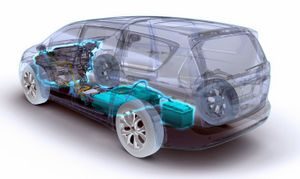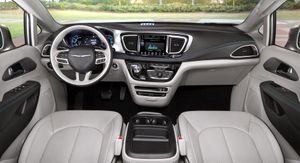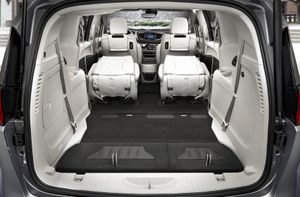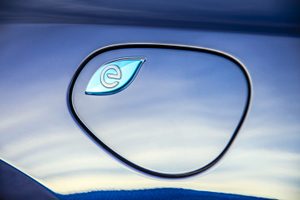Not Just A Hybrid, But A Plug-in Hybrid
Once the king of the road, the minivan segment has seen sales steadily fall through the late 1990s and early 2000s, but then level off. They are now steady and have been for a few years, which shows that for around 500,000 buyers per year, the minivan is still the right answer.

Now, the 2017 Chrysler Pacifica Hybrid has broken new ground with up to 33 miles of fuel-free driving, giving the Honda Odyssey, Toyota Sienna and Kia Sedona some serious new competition. And that’s because the Pacifica Hybrid isn’t just a plain ol’ hybrid, it’s a plug-in hybrid. That means when the battery that provides the 33 miles of electric-only driving is depleted of energy, the Pacifica Hybrid smoothly switches to gasoline-electric hybrid driving.
In hybrid mode the new minivan gets 32 mpg combined city and highway fuel economy according to the EPA. That compares to the low- to mid-20s for those other guys. If you start out with a fully charged battery and a full a tank of gas, you can drive 560 miles before filling the fuel tank or recharging the battery. When operating in electric drive, the Pacifica Hybrid is EPA rated at 84 miles per gallon equivalent (MPGe).
To get that 84 MPGe, it takes just two hours to fully charge the battery using a home charging station with a 240-volt, 30-amp circuit. Or, the battery can be filled with electrons in around nine hours with a standard 120-volt wall outlet.
But Wait, There’s More

In addition to a more stylish appearance inside and out, the Pacifica Hybrid offers a host of available convenience and safety features. Joining the party: hands-free power-sliding side doors and tailgate, a triple-pane sunroof and a rear-seat entertainment system with two 10-inch touchscreens.
The 2017 Pacifica Hybrid is offered in two trim levels. The price tag for the Premium model starts at $41,995 plus destination charges, while the top Platinum edition starts at $44,995. When the federal tax credit of $7,500 is calculated, the cost matches the upper-trim versions of the conventional gas-powered Pacifica. In some states, additional perks and rebates will essentially eliminate the so-called hybrid or plug-in premium.
Minivan Fan—But…
Full Disclosures: First, I am a devout minivan fan. The interior space and flexibility of seating arrangements, not to speak of the sliding passenger doors, make it one of the most versatile vehicles you can buy. Second, I love plug-in hybrids. They can drive a fair amount of emissions-free miles and then switch to the fuel-saving miles of a hybrid. What’s not to like?

So, you can see why I was delighted when Chrysler handed me the keys of their Pacifica Hybrid to drive for a week.
Minivans will never be considered sexy. They are, after all, small school buses with sliding doors, according to my youngest son. However, Chrysler designers did a marvelous job of successfully giving the 2017 Chrysler Pacifica Hybrid and its gasoline sibling an exterior style that is the most elegant minivan available.
The front end has a slim, sleek nose borrowed from the now discontinued Chrysler 200 sedan. The headlights, grille and entire front end present a distinct and handsome face of the minivan world. The side glass is trimmed in bright metal, rear pillars kick back with a relaxed style and sliding doors cover their tracks under the rear windows. The elegant styling continues on the sides, where optional 20-inch wheels give a more dramatic look. In a nod to one upsmanship, the hands free, foot wiggle opening treatment gets applied to the side sliding doors as well to the rear lift gate.
Premium Inside
A Chrysler badge denotes premium vehicle, which is confirmed by stepping inside. The Pacifica Hybrid is awash in upscale looks, highlighted by the thin rim of metallic trim on the steering wheel. The sculpted and stitched dash wraps beautifully around the front passengers, details that speak to the hours of interior design attention. Dash design is simple, with a central control pod that includes Chrysler’s rotary gear shift. The deletion of the center stack below the knees is a big bonus, creating both a place to easily put large items such as purses and briefcases, but also giving the interior a more open feel. A seven-inch color information display and 8.4-inch touchscreen allow the driver to access navigation. Bluetooth phone and audio connectivity are standard and included in the infotainment system.

In addition to the 8.4-inch UConnect touchscreen for managing things up front, there’s UConnect Theater for rear seat passengers, featuring dual 10-inch high definition touchscreens. Audio can be upgraded to a 20-speaker Harmon Kardon system, to hear the best of everything.
Front seating is well-positioned with plenty of legroom and headroom. The Pacifica has the largest total interior storage space in the minivan market, although this version of the minivan seats seven, not eight. Due to the placement of the 16 kilowatt-hour (kWh) battery, the plug-in hybrid doesn’t have the second row Stow N’ Go seats that fold into the floor. Yet, the seating is highly configurable with second-row captain’s chairs. The rest of the cargo features—lots of bins, pockets, and hooks—is intact.
There are 32.3 cubic feet of cargo space behind the third row thanks to a deep tub created when the seats are up for use. When the third row is folded down, the loading floor becomes flat with a very useful 87.5 cubic feet. With the second row removed, cargo expands to a massive 140.5 cubes.
Surround view cameras, parking assistance and various autonomous safety systems such as a blind spot monitoring system and adaptive cruise control are offered.
On The Road
With a lively zero-to-60-mph time of around 7.5 seconds, acceleration is something no one is likely to complain about. This comes courtesy of FiatChrysler’s hybrid system engineered for the Pacifica, and likely to find its way into other vehicles. It starts with the 3.6-liter Pentastar V-6 engine found in the standard gas-powered Pacifica.

Engineers modified the six with different pistons, camshafts, and valves; bumped the compression ratio; and added Atkinson-cycle capability for maximum fuel efficiency. The engine is connected to a continuously variable planetary-gear transmission that houses two electric motor/generators that get electric power from the battery. Chrysler estimates the total output for the hybrid system at 260 horsepower that’s sent to the front wheels.
The real benefit from this system comes in fuel economy, as the Pacifica Hybrid showed me a combined average of 34 mpg for a drive of 182 miles, where the engine was on for the majority of the drive time. In town electric driving was a very excellent 109 MPGe on one occasion. Overall, after chalking up 356 miles, the readout indicated 33.2 mpg.
I am used to driving a minivan (not a Chrysler or Dodge) and I give kudos to the Pacifica for outward vision all around. And more cheers for the surround view camera when backing out of shopping center parking spaces.
The minivan was easy to navigate in urban and suburban traffic. Driving on freeways, the Pacifica Hybrid wasn’t different than piloting an equal-size crossover SUV, but sight lines were better. Steering provided little feedback, although the people hauler always went where it was pointed. The adaptive cruise control did something cool, automatically setting the drivetrain to accelerate when I hit the turn signal when passing or changing lanes. The system, which automatically matches speeds with slower traffic ahead, also brings the Pacifica Hybrid to a complete stop when traffic stops.
The suspension wasn’t close to being sporty, but it was comfortable. There was just enough firmness to keep the Pacifica from jostling about on a curvy road. What really set the new hybrid minivan apart was its interior quiet. Making a big box like this quiet at speed isn’t easy, and Chrysler is way ahead of rivals like the Toyota Sienna and Honda Odyssey.
Turns Out, Pacifica Hybrid Is Not My Cup of Tea
For those not needing eight-passenger seating, the Pacifica Hybrid should be on their minivan shopping list, but it just doesn’t work for me. This is a plug-in hybrid, and as such should have a driving mode that holds the electric charge when driving on freeways for later use in city driving or heavy stop-and-go traffic. Chrysler says that minivan owners don’t want to have to think about maximum efficiency. Well, this minivan driver does.

Even if I could disregard the lack of an electric hold mode, I couldn’t get past the terribly uncomfortable driver’s seat. After a little more than an hour behind the steering wheel, the pain I felt in my back was nearly unbearable. And I’m not alone on this one.
A friend of mine was seriously considering the Pacifica Hybrid. I suggested he test drive one for at least two hours to check out the seat. He called me after driving about an hour and a half to tell me he was asking the sales person to take over because his back, too, was in severe pain. So, my tip is take at least a couple hour test drive.
In the Marketplace
The 2017 Chrysler Pacifica Hybrid doesn’t have any true competitors as it is the only hybrid minivan on the market. However, crossovers can be an alternative to minivans as a family car with passenger and cargo capacity. In that regard, there are a number of hybrid crossovers to cross-shop, such as the Toyota Highlander Hybrid, Acura MDX Sport Hybrid and Lexus RX 450hL. But these tend to be five-passenger vehicles or have less than comfortable third row seats. Most also don’t offer extended electric-only driving.
In order to give you, the reader, the best perspective on the many vehicles available, Clean Fleet Report has a variety of contributors. When possible, we will offer you multiple perspectives on a given vehicle. We hope you’ll enjoy these diverse views–some are just below—and let us know what you think in comments below or at publisher@cleanfleetreport.com.
Road Test: 2017 Chrysler Pacifica (John’s view)
First Drive: 2017 Chrysler Pacifica (Michael’s view)
News: 2017 Chrysler Pacifica Plug-in Minivan
Related Stories You Might Enjoy:
News: Lexus Introduces 3-Row Hybrid RX
Road Test: 2017 Acura MDX Sport Hybrid
First Drive: 2017 Acura MDX Sport Hybrid
Road Test: 2014 Toyota Highlander Hybrid
Disclosure:
Clean Fleet Report is loaned free test vehicles from automakers to evaluate, typically for a week at a time. Our road tests are based on this one-week drive of a new vehicle. Because of this we don’t address issues such as long-term reliability or total cost of ownership. In addition, we are often invited to manufacturer events highlighting new vehicles or technology. As part of these events we may be offered free transportation, lodging or meals. We do our best to present our unvarnished evaluations of vehicles and news irrespective of these inducements.
Our focus is on vehicles that offer the best fuel economy in their class, which leads us to emphasize electric cars, plug-in hybrids, hybrids and diesels. We also feature those efficient gas-powered vehicles that are among the top mpg vehicles in their class. In addition, we aim to offer reviews and news on advanced technology and the alternative fuel vehicle market. We welcome any feedback from vehicle owners and are dedicated to providing a forum for alternative viewpoints. Please let us know your views at publisher@cleanfleetreport.com.

I am a 6′ 2″ male weighing 215 pounds and I have owned my 2017 Pacifica Hybrid Platinum for about 3 months and 7000 miles. About two-thirds of those miles have been logged in multi-hour chunks on the highway for work. Although there are a few minor things I would change, I am delighted with my new vehicle.
I have no idea why you find the seats exceptionally uncomfortable; with height-adjustable lumbar and a tilt-telescope wheel I have no problem with comfort. Other reviews have mentioned the lower cushion being too narrow and pressing against the thighs, but I have not noticed this either. If I could change anything, I’d make the inboard armrest someone softer against my elbow. My brother owns a 2018 Honda Odyssey Touring Elite and overall I find the Chrysler to be its equal in seat comfort for me.
As an engineer and lover of technology, I also wish Chrysler had included some of the information and control modes available in other PHEVs. (For instance, would it have been so hard to show charging voltage and amperage in addition to charging power expressed only to the nearest whole kilowatt?) However, after interacting with a number of people about the Pacifica, I have been asked more than once what I do when the electricity runs out. Most people have no clue as to how hybrids, plug-in or otherwise, work. Consequently, to gain acceptance in the marketplace beyond enthusiasts, I think that making the driving experience as invisible as possible is understandable even though I might personally prefer differently.
@A.Johnson,
Great comments. Here’s John’s response:
I am dumb founded about the seat. In nearly thirty years of test driving vehicles, I have never experienced such an uncomfortable feeling. Would not have written about it had it not been for friend’s similar experience, who incidentally, physically mirrors you.
As for not being able to hold juice in the battery for later use, that feature would cost very little, and for those who do not understand plug-in hybrids it wouldn’t take much to educate them. Congratulations on accepting Chrysler not including it. That is something I couldn’t accept. –Larry
Looks like a great hybrid car to me, Great work by Chrysler
@Md Farzeen,
It’s a one-of-a-kind right now! –ed.
that’s surprising really!